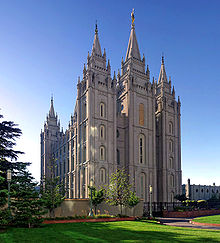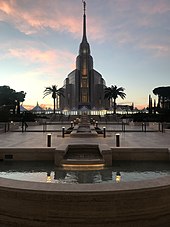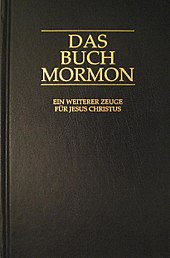Mormonism
![]()
The articles Mormons and Mormonism overlap thematically. Information that you are looking for here may also be found in the other article.
You are welcome to participate in the relevant redundancy discussion or directly help to merge the
articles or better distinguish them from each other (→ instructions).
Mormonism (also Mormonism) includes all Christian denominations that refer to the Book of Mormon in addition to the Bible. According to Mormon tradition, Joseph Smith, Jr. translated the Book of Mormon in 1827 from golden plates he found in the Hill Cumorah. The vast majority of Mormon denominations know of other revelations that have been summarized in the Doctrine and Covenants.
In 1830 Smith founded the first Mormon religious community, the Church of Christ. From it emerged the Community of Christ, which today is the second largest Mormon church with about 250,000 members. It was recognized in 1880 as the legal successor to the original Church of Christ and is therefore in possession of the oldest temple - the Mormons call their central branches "temples" - and most of the documents from the estate of Joseph Smith, Jr.
The largest Mormon church with 16 million members is the Church of Jesus Christ of Latter-day Saints (often abbreviated HLT; English: The Church of Jesus Christ of Latter-day Saints; abbreviated LDS), which has existed since 1838. It is mostly referred to when Mormons are mentioned, although since 2018 it no longer wants to be called that.

The Salt Lake Temple of the Church of Jesus Christ of Latter-day Saints is the best-known architectural symbol of Mormonism
Geographical distribution
Mormons live predominantly in the United States, with a focus on Utah and neighboring areas in Arizona, Wyoming and Idaho, as well as Missouri and Kansas. In addition, the Church of Jesus Christ HLT in particular has been engaged in international missions since 1974 and has members in many countries around the world.
According to its own figures, the Church of Jesus Christ HLT has about 16.1 million baptized members worldwide, 6.6 million of whom live in the United States. About 60% live in North America, 25% in South America, 10% in the Anglo-Saxon nations of the United Kingdom, Australia, and the Asian island nations, especially the Philippines and Japan, and only 5% in continental Europe, continental Asia, and Africa combined. In Europe, the church claims to have over 510,000 members in 40 countries and about 1300 local groups/churches. In Germany there are over 40,000 members of the Church of Jesus Christ HLT, 4600 in Austria and over 9000 in Switzerland. The official figures include all baptisms of converts by the church as well as newly registered children who have been blessed in a church service. However, outside the United States, ties to the church are considered rather loose. Thus, only 1.8% of the approximately 2.25 million baptized in South America would also have entered into a temple marriage, which is so important for members of the church.

Rome temple at sunset
Beliefs and relation to Christianity
See also: Differences between the Community of Christ and The Church of Jesus Christ of Latter-day Saints
The Book of Mormon, following biblical events, describes complementary settlements of America and historical excerpts of some past American cultures: A first wave of settlement had already taken place after the Babylonian confusion of languages; however, the Jaredites who had emigrated to America at that time had died out before another wave of immigration occurred. This second group had emigrated after the destruction of Jerusalem by the Babylonian king Nebuchadnezzar II and the beginning of the Babylonian exile in 598 BC. These people would have belonged to the tribes of Israel and after some time would have divided into the Nephites, who kept the commandments of God, and the Lamanites, who apostatized from the faith.
The God-fearing Nephites were visited by Jesus Christ immediately after his resurrection, and he imparted a kernel of the gospel to them before he ascended into heaven. After several wars between the groups, the Nephites were completely destroyed at the beginning of the 5th century AD. The Lamanites, who had already taken on a darker skin color after the secession from the Nephites, remained and are counted among the ancestors of the American Indians. The Prophet Mormon had recorded the story on gold plates in "reformed Egyptian." The last surviving Nephite was the prophet Moroni, who hid the plates in the hill Cumorah.
In 1823, Moroni is said to have appeared to Joseph Smith, Jr. as an angel in Manchester, New York, where he handed Smith clues as to where these plates could be found. Smith is said to have discovered the plates in 1827 in the hill Cumorah and translated them into English with the help of the seer stones Urim and Thummim before he had to return them to Moroni. This text forms the Book of Mormon.
In the course of his life, Smith also summarized 133 revelations in his work Doctrine and Covenants, which was supplemented and revised several times. Among them are instructions about the church organization, deepening doctrines of salvation, temporal instructions and further ways of life such as instructions for multiple marriages and regulations for the baptism of the deceased in the form of living substitutes, in order to enable the already deceased to be received into the church and eternal life. In addition to additions to the Bible, which were later published in the volume Delicious Pearl, Smith acquired a collection of ancient Egyptian papyri from a dealer and published the Book of Abraham, which contains further teachings that are said to be an inspired translation of the papyri (also included in the volume Delicious Pearl). Alongside these church writings are records of Smith's doctrinal talks and lectures as another foundation of today's Mormon religious communities.
The image of God of almost all Mormon faiths is antitrinitarian. God, Jesus Christ, and the Holy Spirit stand side by side as distinct persons. The believers assume a possibility of ascending to divine dignity even beyond redemption, just as "God was once a man". Critics therefore accuse them of polytheism: "The Mormons worship only one God, but believe that there are others besides him who, like him, have attained divine exaltation. Even God himself was once a man who matured into a god through learning, testing, and growth."
In a departure from this, the second largest Mormon church, the Community of Christ, teaches a Trinitarian image of God. It has also recognized the Nicene Creed and uses the cross as a symbol in its church, while the Church of Jesus Christ of Latter-day Saints rejects the cross as a central identifying mark.
The members of the Church of Jesus Christ of Latter-day Saints call themselves decidedly Christians and see themselves in possession of the original Christian beliefs through Joseph Smith's revelations to the "Great and Abominable Church". They are therefore to be counted as part of a Restoration movement, which, according to their own convictions, preserve an original Christianity corresponding to Arianism. In contrast, the large Christian churches point out that according to the New Testament the Christian principles of faith were concluded with Jesus Christ and that therefore new revelations were not possible. Furthermore, Mormon convictions about the nature of God are not compatible with the Christian concept of the Trinity and salvation by the grace of God with Christian principles (according to the views of Athanasius).
In contrast, the major Christian churches take the position that after the canonization of the New Testament, the Christian tenets of faith are complete and new revelations are not possible. The major Christian churches do not consider the Church of Jesus Christ of Latter-day Saints to be a Christian religion, but a "separate, syncretistic new religion" and do not recognize its members as baptized Christians. In contrast, the baptism of the Community of Christ is recognized. This position is held by the Roman Catholic Church, the United Evangelical Lutheran Church of Germany, the Evangelical Methodist Church, and the Presbyterian Church.
According to a 2007 survey, 51% of U.S. Americans say they know very little about Mormonism. A slim majority of 52% of U.S. respondents considered Mormonism to be a Christian religion, while just under one-third (31%) did not consider Mormonism to be a Christian religion.

German HLT edition of the Book of Mormon
Questions and Answers
Q: What is Mormonism?
A: Mormonism is a Christian restorationist religious movement that was founded by Joseph Smith. It is also called the Latter Day Saint movement and the largest and best known Mormon church is The Church of Jesus Christ of Latter-day Saints.
Q: Do Mormons consider themselves to be Christian?
A: Yes, Mormons consider themselves to be Christian, although some non-members do not agree with this assessment. A 2007 survey showed that 31% of people polled did not agree that Mormons are Christians.
Q: What beliefs do Mormons have that differ from mainstream Christianity?
A: Mormons have beliefs that are different from the beliefs of mainstream Christian churches. The Mormon Church considers itself a restoration church which means members believe it is the original Christian Church started by Jesus Christ and brought back ("restored") by Joseph Smith, Jr. in 1830.
Q: Are Mormonism or Bahaism considered "fourth Abrahamic religions"?
A: Yes, both Mormonism and Bahaism are sometimes referred to as "fourth Abrahamic religions".
Search within the encyclopedia